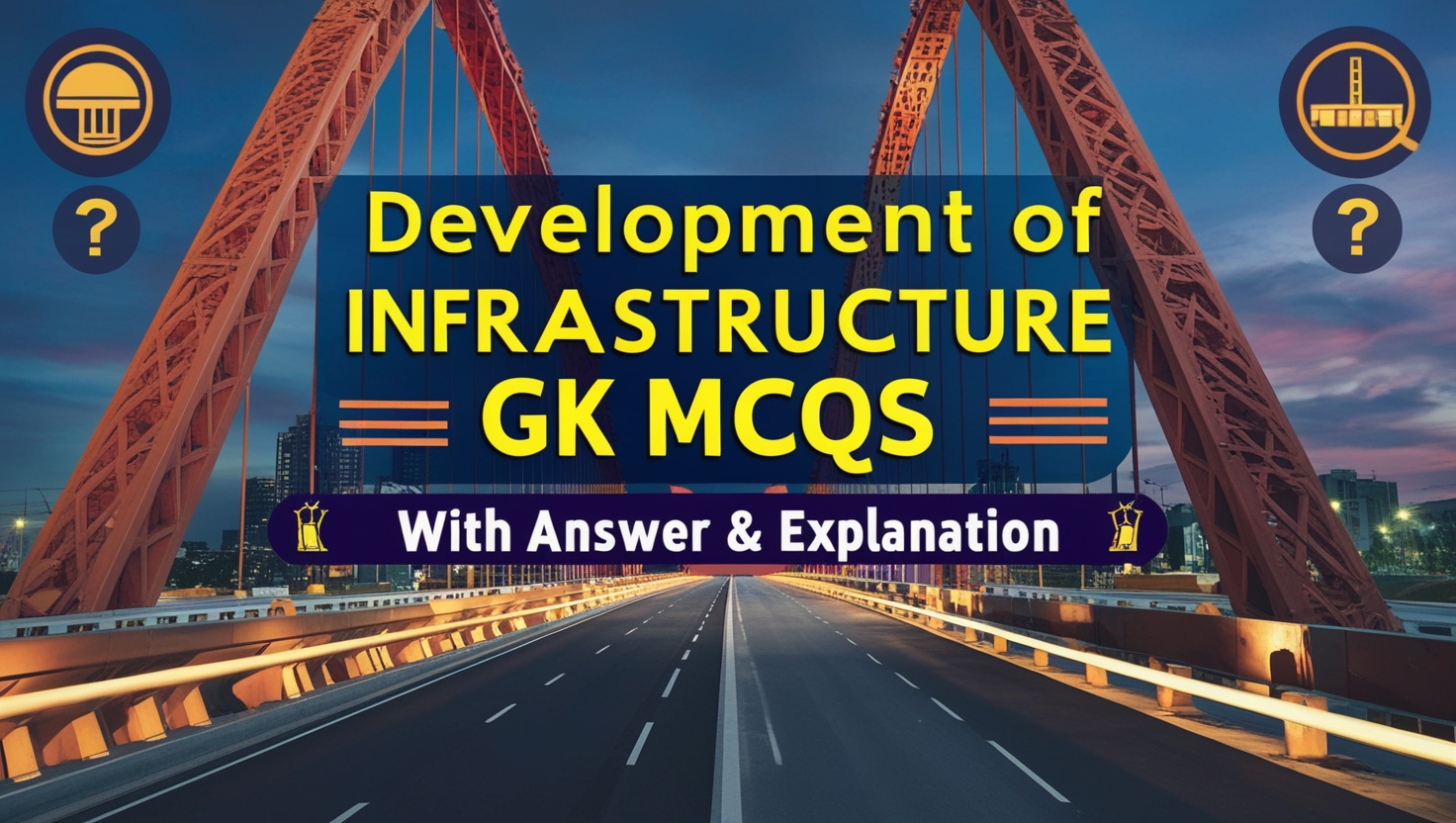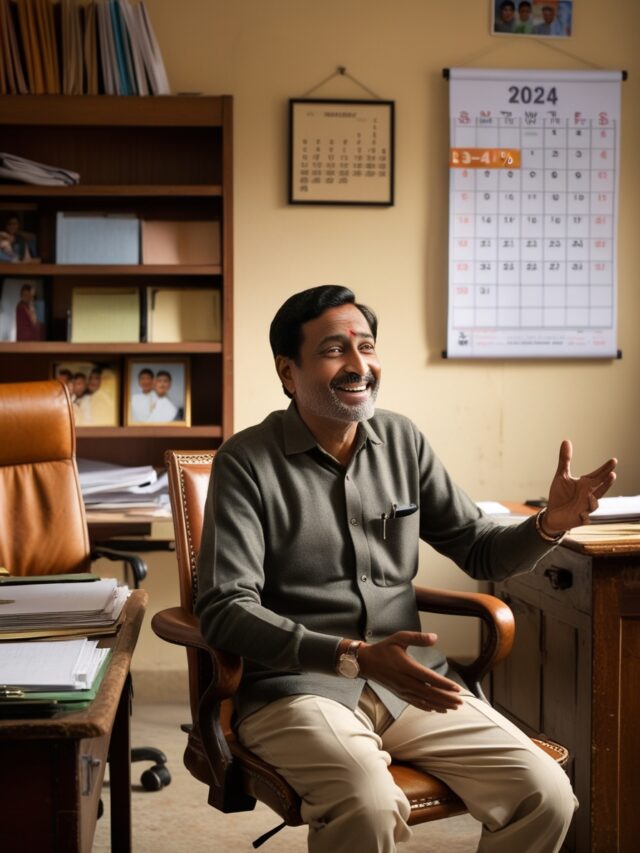
1. Which among the following is India’s first Oil refinery?
- Guwahati Refinery
- Visakhapatnam Refinery
- Digboi Refinery
- Barauni Refinery
Show Answer
Answer: Digboi Refinery
Digboi is a town in the northeastern Indian state of Assam, where the first oil well in Asia was drilled. The first oil refinery in India was established in Digboi as early as 1901. This marked a significant milestone in India’s industrial development, particularly in the oil and petroleum sector. The discovery of oil in Digboi played a crucial role in shaping India’s energy industry.
2. 1853 is a landmark in India’s Transport because of?
- First train
- First cargo plane
- First ship
- None of them
Show Answer
Answer: First train
In 1853, the first passenger train in India ran between Bombay (now Mumbai) station and Thane. This marked a historic moment in India’s transportation history as it was the inception of India’s railway network. The introduction of the railways was a transformative development, greatly enhancing connectivity and facilitating the movement of people and goods across the country.
3. In which century, the maximum investment was made by the British in the Core & Infrastructure sector in India?
- 17th century
- 18th century
- 19th century
- 20th century
Show Answer
Answer: 19th century
During the 19th century, the British colonial administration made substantial investments in India’s infrastructure sector. This included the development of various key industries such as railways, cotton mills, jute mills, steel industries, and ship and navigation industries. These investments were part of the British strategy to strengthen their economic control and industrial infrastructure in India, which had far-reaching consequences for the country’s economic development.
4. In which year was the Imperial Records Department (IRD) established, which is now known as the National Archives of India?
- 1885
- 1887
- 1889
- 1891
Show Answer
Answer: 1891
The Imperial Records Department (IRD) was established on 11th March 1891 in the Imperial Secretariat Building in Calcutta (Kolkata). The IRD was responsible for preserving and maintaining official records, documents, and archives related to British India. It played a significant role in documenting the administrative and historical records of the colonial period, contributing to the understanding of India’s history.
5. In which year was the Submarine Telegraphy System opened between India and Europe?
- 1860
- 1862
- 1865
- 1880
Show Answer
Answer: 1865
The Submarine Telegraphy System between India and Europe was established in 1865 and 1866. The first cable reaching India from Aden, Yemen, was opened in 1870. These developments marked a significant advancement in communication between India and Europe, reducing the time required for transmitting messages across vast distances and enhancing international connectivity.
6. The “Guarantee system” for Rail Network development in India was started in which year?
- 1843
- 1849
- 1855
- 1859
Show Answer
Answer: 1849
The “Guarantee system” for rail network development in India was initiated in 1849 and discontinued in 1869. Under this system, private British companies were appointed to develop railways with certain conditions. The government provided free land, offered a 5 percent interest on the invested amount of the companies, and shared profits after paying the interest. However, it was discontinued in 1869 due to concerns about the financial burden it placed on the government. It was later reintroduced in 1880 with modifications to encourage private investment in railway development while mitigating financial risks.
7. The Great Indian Peninsula Railway was founded in which year?
- 1849
- 1853
- 1866
- 1905
Show Answer
Answer: 1849
The Great Indian Peninsula Railway (GIPR) was founded on 1st August 1849 and incorporated by an act of the British Parliament. Its headquarters was located in Boree Bunder, Mumbai. The GIPR played a pivotal role in India’s railway development, connecting important regions and cities.
8. Which among the following statements about the “Guarantee system” is correct?
- The government provided free land to the companies involved.
- The government provided 5 percent interest on the invested amount of the companies.
- It was decided to divide the profit equally between the government and the companies.
- All of the above
Show Answer
Answer: All of the above
The “Guarantee system” for Rail Network development in India, started in 1849, involved the government providing free land, 5 percent interest on the invested amount of the companies, and the division of profits between the government and the companies after paying the interest.
9. The “Guarantee system” was started again in which year after it was discontinued in 1869?
- 1970
- 1875
- 1880
- 1885
Show Answer
Answer: 1880
The “Guarantee system” for railway development in India, which was initiated in 1849, was discontinued in 1869 due to concerns about the financial burden it placed on the government. However, it was reintroduced in 1880 with some modifications. The modified system continued to provide a guaranteed rate of return on capital invested by the companies in railway construction, with the government sharing in the profits after the guaranteed interest had been paid. This modified system aimed to encourage private investment in railway development while mitigating the financial risks for the companies involved.
10. Which committee was appointed for the extension of the Rail Line and the development of Railway administration?
- Lee Committee
- Acworth Committee
- Hunter Commission
- Stanley Committee
Show Answer
Answer: Acworth Committee
The Acworth Committee was appointed in 1919 to address the extension of the rail network and the development of railway administration. Its recommendations included significant investments of Rs. 150 crores every five years and the separation of the rail budget from the general budget. However, it did not recommend the abolition of privatization for railway development.
Q11: The Raleigh Commission:
1. Was appointed by Lord Curzon
2. Its main aim was to inquire into the conditions and prospects of the universities
Choose the right code:
1. Only 1
2. Only 2
3. Both 1 and 2
4. None of the above
Show Answer
Answer: 3
Explanation: The Raleigh Commission, appointed by Lord Curzon, had the primary objective of investigating the conditions and prospects of universities in India. This commission’s findings and recommendations contributed to reforms in university education during the colonial period.
Q12: Consider the following statements about the Sadler Commission:
1. It was the first commission to review education from school education to university education.
2. It provided for secondary and intermediate education to be controlled by a board of secondary education.
Choose the right option
1. 1 Only
2. 2 Only
3. Both 1 & 2
4. Neither 1 nor 2
Show Answer
Answer: 3
Explanation: The Sadler Commission, also known as the Calcutta University Commission, conducted a comprehensive review of education from school to university levels. It recommended the separation of secondary and intermediate education from degree colleges, advocating the creation of a separate board for secondary education. The commission’s insights had a profound impact on the education system in India.
Q13: Which of the following is also called the Scheme of Post War Educational Development in India?
1. Sargent Report
2. Abbot-Wood Report
3. Saddler Commission Report
4. Hartog Committee Report
Show Answer
Answer: 1
Explanation: The Sargent Report, also referred to as the Scheme of Post War Educational Development in India, recommended the establishment of the University Grants Commission (UGC) and proposed a three-year degree course. The UGC became a key institution for regulating higher education in India.
Q14: Consider the following statements about the Hartog Committee:
1. The committee was set up during the reign of Lord Irwin.
2. It was set up to investigate the Anglo-Asian opium trade.
Choose the right option:
1. 1 Only
2. 2 Only
3. Both 1 & 2
4. Neither 1 nor 2
Show Answer
Answer: 1
Explanation: The Hartog Committee, established in 1929 during Lord Irwin’s tenure, was indeed tasked with assessing the growth and standard of education in British India. It was chaired by Sir Philip Joseph Hartog, and its primary focus was to recommend measures to address the issues arising from the proliferation of educational institutions.
Q15: Consider the following statements about Wood’s Despatch:
1. It proposed setting up several vernacular primary schools in the villages.
2. It encouraged privatization in the field of education.
3. It encouraged developing practical and vocational skills of Indian people.
4. It recommended English as the language for higher education.
Choose the right option
1. Only 1, 2 & 3
2. Only 2, 3 & 4
3. Only 1, 3 & 4
4. 1, 2, 3 & 4
Show Answer
Answer: 3
Explanation: The correct statements are indeed 1, 3, and 4. Wood’s Despatch of 1854 proposed the establishment of vernacular primary schools to promote education at the grassroots level. It also emphasized practical and vocational skills development and recommended the use of English as the medium of instruction for higher education.
Q16: Which among the following objectives of the Charter Act of 1813 for education is/are correct?
1. To encourage educated Indians.
2. To provide knowledge of Modern science.
3. It asked the Company to provide 1 Lakh rupees for educational upliftment.
Choose the right option
1. 1 only
2. 1 & 3
3. 2 & 3
4. 1, 2 & 3
Show Answer
Answer: 2
Explanation: The Charter Act of 1813 aimed to encourage the education of Indians and allocated a sum of Rs. 1 lakh specifically for educational upliftment. This marked the first instance of a financial allocation for educational purposes in India.
Q17: Who among the following wrote a letter to Lord Amherst for some demand related to education?
1. Henry Louis Vivian Derozio
2. Ram Mohan Roy
3. Vidyasagar
4. Madhusudan Dutt
Show Answer
Answer: 2
Explanation: In 1823, Raja Rammohan Roy wrote a letter to Lord Amherst, emphasizing the importance of providing education to Indians in various subjects, including Mathematics, Natural Science, Chemistry, Osteology, and Western Philosophy. His advocacy for a broad and modern education curriculum was ahead of its time.
Q18: Who among the following said, Indian learning was inferior to European learning?
1. Lord Macaulay
2. Drinkwater Bethune
3. Jonathan Duncan
4. Lord Wellesley
Show Answer
Answer: 1
Explanation: Lord Macaulay is famously associated with the view that Indian learning was inferior to European learning. His Minute of Education in 1835 advocated for promoting English education and de-emphasizing support for Oriental learning, a stance that had a significant impact on the educational policies of the time.
Q19: Who among the following focused on providing Village education?
1. Lord Macaulay
2. Drinkwater Bethune
3. James Thomson
4. Warren Hastings
Show Answer
Answer: 3
Explanation: James Thomson, the Lieutenant Governor of the Northwest Provinces, indeed focused on providing village education to train personnel for the Public Works Department. This move aimed to develop practical skills among the local population.
Q20: In the year 1857, Universities were set up in which among the following places?
1. Calcutta
2. Bombay
3. Madras
4. Delhi
Choose the right code:
1. 1 only
2. 1 & 3
3. 1, 2 & 3
4. 1, 2, 3 & 4
Show Answer
Answer: 3
Explanation: In 1857, universities were indeed established in Calcutta, Bombay, and Madras, marking a significant development in higher education during the colonial era.
Q21: Bethune School was founded in which year?
1. 1839
2. 1849
3. 1859
4. 1869
Show Answer
Answer: 2
Explanation: Drinkwater Bethune founded Bethune School (Girl’s School) in Kolkata in 1849, and it later evolved into a college in 1879. This institution played a crucial role in the promotion of women’s education in India.
Q22: The establishment of Sanskrit College at Calcutta was opposed by who among the following?
1. William Digby
2. Rabindranath Tagore
3. Raja Rammohan Roy
4. William Bentinck
Show Answer
Answer: 3
Explanation: Raja Rammohan Roy opposed the establishment of Sanskrit College at Calcutta due to his dissatisfaction with its teaching methodology and the limited scope of its curriculum. He was a strong advocate for a modern and diverse education system.
Q23: Which among the following resolutions of the Minute of Lord Macaulay are correct?
1. Extension of European literature and science.
2. Assisting the students for Oriental learning was stopped.
3. Oriental works would not receive Government funds.
4. Government funds would be utilized for English literature and science.
Choose the right option:
1. 1 & 2
2. 1, 2 & 3
3. 1, 3 & 4
4. 1, 2, 3 & 4
Show Answer
Answer: 4
Explanation: The Minute of Lord Macaulay in 1835 laid out a comprehensive plan to extend European literature and science, stop aiding Oriental learning, cease funding Oriental works, and utilize government funds for the promotion of English literature and science.
Q24: Which educational commission focused mainly on Primary and Secondary education?
1. Hunter Commission
2. Wood’s Despatch
3. Macaulay Minutes
4. Resolutions of 1913
Show Answer
Answer: 1
Explanation: The Hunter Commission, appointed by Lord Ripon in 1882, primarily focused on primary and secondary education, with particular attention to female education.
Q25: Who among the following described the Indian Universities Act of 1904 as a retrograde measure?
1. Gopal Krishna Gokhale
2. Raja Rammohan Roy
3. M.G. Ranade
4. C.R. Das
Show Answer
Answer: 1
Explanation: Gopal Krishna Gokhale did, in fact, describe the Indian Universities Act of 1904 as a retrograde measure. This act had implications for the administration and structure of universities in India.
Q26: Saddler Commission was appointed mainly to investigate the problems of which among the following universities?
1. Bombay University
2. Calcutta University
3. Delhi University
4. Kanpur University
Show Answer
Answer: 2
Explanation: The Saddler Commission, appointed in 1917, primarily examined the issues within Calcutta University. However, its recommendations often had a broader impact, benefiting other universities as well.
Q27: Hartog committee was appointed in which year?
1. 1929
2. 1942
3. 1948
4. 1964
Show Answer
Answer: 1
Explanation: The Hartog Committee, formed in 1929, aimed to address the challenges associated with the expansion of educational institutions. Sir Philip Joseph Hartog chaired this committee, and it played a role in shaping educational policies in British India.
Q28: Who among the following was appointed as the chairman of the committee to formulate the scheme of basic education in India in the Wardha educational conference?
1. N.S. Reddy
2. William Hunter
3. Maulana Azad
4. Zakir Hussain
Show Answer
Answer: 4
Explanation: In the Wardha educational conference held in 1937, Dr. Zakir Hussain chaired the committee responsible for formulating the scheme of basic education. This conference had a profound influence on the direction of education in India.
Q29: Which of the following committee’s main objective was to achieve the level of literacy in India similar to England within 40 years?
1. Saddler Commission
2. Macaulay’s Minutes
3. Sergeant Plan
4. Wardha scheme
Show Answer
Answer: 3
Explanation: The Sergeant Plan, developed in 1944, had the main objective of achieving a level of literacy in India similar to England’s within 40 years. It also recommended the abolition of the intermediate course in education.
Q30: Which among the following commission recommended placing university education into the concurrent list?
1. Radhakrishnan Commission
2. Hartog Commission
3. Saddler University Commission
4. Hunter Commission
Show Answer
Answer: 1
Explanation: The Radhakrishnan Committee, set up in 1948, suggested placing university education on the concurrent list. This committee’s recommendations had a significant impact on the governance and administration of universities.
Q31: University Grants Commission was constituted in which year?
1. 1953
2. 1958
3. 1959
4. 1962
Show Answer
Answer: 1
Explanation: The University Grants Commission (UGC) was indeed constituted in 1953, with the recommendation of the Radhakrishnan Committee. The UGC received statutory status through an Act of Parliament in 1956, establishing its role in regulating and coordinating higher education in India.
Q32: Which among the following are correct about the Kothari Commission?
1. It was appointed in 1964
2. Daulat Singh Kothari was its chairman
3. It suggested compulsory education up to 14 years
4. It also focused on agriculture education
Choose the right option
1. 1 & 3
2. 2 & 3
3. 2, 3 & 4
4. 1, 2, 3 & 4
Show Answer
Answer: 4
Explanation: The Kothari Commission was appointed in 1964, with Daulat Singh Kothari as the chairman. It suggested compulsory education up to the age of 14 and also focused on Agriculture education.
Q33: Arrange the following educational commissions chronologically:
1. Hunter Commission
2. Kothari Commission
3. Radhakrishnan Commission
4, Saddler Commission
Choose the right option
1. 1, 2, 3, 4
2. 1, 4, 3, 2
3. 1, 3, 4, 2
4. 1, 2, 4, 3
Show Answer
Answer: 2
Explanation: The chronological order of the commissions is:
1. Hunter Commission (1882)
2. Saddler Commission (1917)
3. Radhakrishnan Commission (1948)
4. Kothari Commission (1964)







